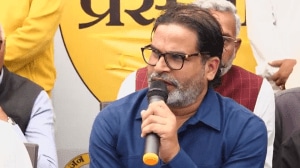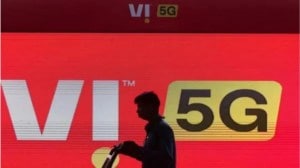From kiddie toys to solar cookers
ENERGYLESS PUMP: Byrne with a rope-and-washer pump. APPROPRIATE CHOICE: Philip Byrne. In a world where the giant wheel of technology is...

ENERGYLESS PUMP: Byrne with a rope-and-washer pump.
APPROPRIATE CHOICE: Philip Byrne.
In a world where the giant wheel of technology is sweeping away the small but vital modes of development, appropriateness of technology is still a far cry. But a 63-year-old Irishman has been doing his bit to popularise appropriate technology in India for the past 30 years.
Tucked away in the relatively nondescript town of Harda in Hoshangabad district of Madhya Pradesh, Philip Byrne has been busy making energyless’ pumps for the benefit of those who cannot afford to have the electrical ones in their farms. And these pumps are among many other devices Byrne has been making and demonstrating during his long stay in India.
From children’s toys to solar cookers and from threshers and home-made cyclostyling machine to the energyless pumps, Byrne has been relentlessly involved in the pursuit of what has remained neglected in the planning process of the country, but is needed most.
Ever since his arrival at Sevagram Ashram in 1967, Byrne has been holding workshops and seminars and installing appropriate technology equipment all over the country. After acquiring basic workmanship in Ireland and England, Byrne came as a young man to Sevagram to run a rural development workshop on Gandhian lines. The typical Gandhian ambience turned Byrne into a pacifist.
After spending a few years there, he went back to England and later to Ireland to earn money so that he could come back to India to start his own workshop. The Irish experience saw a metamorphosis in Byrne’s thinking. He realised that pacifism doesn’t work in isolation and hence turned towards Marxism.
But during this transformation, his dedication to appropriate technology, a common cause with Gandhians and Marxists, remained unflinching. After about a year-and-a-half, he returned to Wardha. There, he started a unit to manufacture imaginative toys for kids. The toys are still available at select outlets at cheaper prices than those in the market, thanks to the workers whom Byrne trained in his workshops.
He then turned his attention to more important things like solar cookers and threshers. He taught innumerable kids and workers how to make solar cookers at home. He also devised his own model of a thresher which he claims is better than the popular ones available in the market. Byrne says that, however, he could not further his work to a wider target of users because of lack of support from the Ministry of Energy.
Not one to be disheartened, Byrne turned his attention to two models of energyless’ pumps designed by an American appropriate technology organisation and decided to popularise them here, aware as he was of the promise they held for a predominantly agricultural country like India.One of these pumps, called the rope-and-washer pump, works on the technique of ropes and pulleys which are installed on a high wooden platform. A long pipe with one end immersed in the source of water has a rope passing through it. The rope has a chain of washers attached to it. Even as a person sitting at the bottom of the wooden platform pedals the pulley in front of him, the rope-and-washer system gets pulled through the immersed end of the pipe, pulling along a sizeable amount of water which gets pumped into a trough near the upper pulley. From there, the water is then carried to the field under gravity. At lifts of up to five metres, an output of one litre per second can be sustained and areas of about 0.25 hectare can be irrigated, assuming that the pump is operated by one person for 20 hours every week.The simple technique was known to the Chinese since ancient times and is in use there even today, reveals Byrne who has installed the pump in many States in the last few years. Apart from being available at an affordable price of Rs 1,500, the pump needs negligible maintenance. And of course, no electric power is required to run it.
The other pump is known as the hydraulic ram pump. It works on hydraulic pressure exerted by at least a six-foot head of water. The whole assembly of steel pipes and valves works on a sort of make-and-break arrangement which continues uninterrupted for hours. It can be installed at a reasonable price of Rs 2,500 and is also very easy to maintain and operate. A minimum head of six feet of water, however, must be maintained to make the pump run. Byrne is now busy making modifications to make the pump run even with a four-foot water head.
But Byrne’s effort has remained a solitary one in the absence of much-needed back-up from those who should care for appropriate technology. It would be appropriate to give this Byrne a real fillip.
Preserving the future?
Philip Byrne, a small, diminutive figure with typical Irish looks has come a long way, literally. Youthful restlessness brought him to Sevagram, in Wardha district of Maharashtra. He got attuned to a totally alien land and culture with unusual ease. After his second coming to India, Byrne worked at places like Satara, Hyderabad and Varanasi.
At Varanasi, he was spotted by Eklavya, an NGO in Madhya Pradesh, which invited him to work for their project in Harda. Funded by the Oxfam Trust, the Eklavya Appropriate Technology Service Workshop at Harda has been run by Byrne for the past seven years.As a Marxist he feels he cannot be shackled by the narrow’ confines of citizenship and is as much a citizen of India as that of Ireland, England or any other country. Not caring for bureaucratic hurdles, Byrne has internalised the hard ways of living in India with an amazing skill and has endeared himself to many people.After deciding to settle down in India he got married to an Indian woman with whom he has two sons.
Appropriate technology, as Byrne defines it, is one which mankind can afford. And why did he choose appropriate technology as his field of work, knowing fully well that it does not find favours with the powers-that-be?. “It is something that needs to be preserved for the future,” says Byrne.





- 01
- 02
- 03
- 04
- 05


























